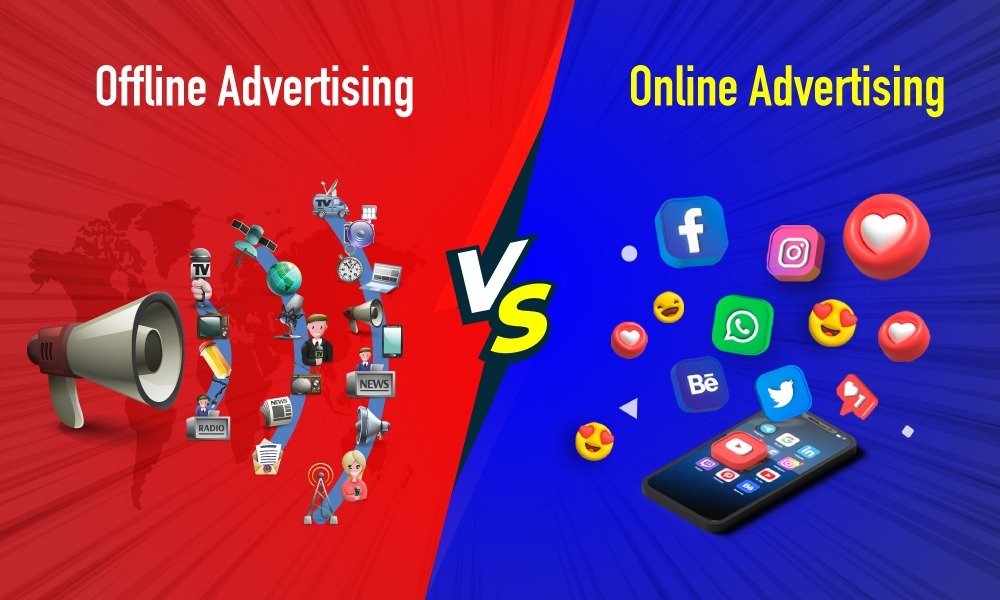Difference Between Online and Offline Marketing
In the ever-evolving world of advertising, businesses face the crucial decision of choosing between offline marketing and online marketing. Both strategies have their strengths and limitations, and businesses must understand these differences to create a well-rounded marketing plan. Eumaxindia, a leading advertising agency, offers valuable insights into how both offline and online marketing work and where they differ. Below are the key differences between the two approaches:
1. Targeting and Reach
- Online Marketing: Online advertising allows for precise targeting. Through tools like social media ads, search engine marketing, and display advertising, businesses can target specific demographics, behaviors, locations, and even interests. This precise targeting leads to higher efficiency and better returns on investment (ROI).
- Offline Marketing: Offline advertising, such as TV, radio, and billboards, typically reaches a broader audience but lacks the same precision in targeting. While it is effective in reaching mass markets, it may not be as efficient when trying to reach a niche audience.
2. Engagement and Interaction
- Online Marketing: Digital marketing allows for immediate and interactive engagement. With features such as clickable ads, social media comments, and email responses, businesses can engage with their audience directly and instantly. This creates a sense of connection and fosters brand loyalty.
- Offline Marketing: Traditional offline marketing methods tend to be more one-way. The audience passively receives the message without direct engagement. However, events, product launches, and exhibitions can allow for face-to-face interaction, which can build deeper connections with customers.
3. Data and Analytics
- Online Marketing: One of the key advantages of online advertising is the ability to measure performance in real time. Businesses can track metrics such as click-through rates, conversion rates, website traffic, and social media engagement. This data-driven approach allows businesses to adjust and optimize campaigns in real time.
- Offline Marketing: Offline campaigns generally lack detailed, real-time performance tracking. Although businesses can gauge effectiveness through indirect methods like sales data or surveys, they can’t measure specific campaign outcomes as precisely as they can with digital ads.
4. Cost-Effectiveness
- Online Marketing: Online advertising is often more budget-friendly, especially with models like pay-per-click (PPC). This allows businesses to control spending by setting precise budgets and paying only when ads generate clicks or conversions. This makes online marketing more cost-effective, especially for businesses with limited budgets.
- Offline Marketing: Traditional offline marketing tends to involve higher upfront costs, such as the production and distribution of physical materials (e.g., brochures, billboards, and TV ads). However, it can still be a long-term investment, particularly when businesses aim to build brand trust and recognition in local markets.
5. Content Relevance and Personalization
- Online Marketing: Digital marketing allows businesses to tailor content specifically to their target audience. By using techniques like keyword targeting, retargeting, and behavior tracking, online advertising ensures that the content is contextually relevant, which leads to higher engagement and conversion rates.
- Offline Marketing: Offline advertising tends to be less personalized, as it is aimed at a broader audience. However, businesses can still enhance content relevance by selecting the right channels and ensuring the message aligns with their target demographic.
6. Brand Awareness and Longevity
- Online Marketing: Online marketing is more transient; once a digital campaign ends, it may be quickly forgotten unless the business continues engaging with its audience through ongoing campaigns. However, online advertising allows businesses to build brand awareness continuously with a sustained online presence.
- Offline Marketing: Offline advertising, such as billboards and print ads, has a longer-lasting impact, particularly in high-traffic areas. People often remember physical ads they see in the real world, and these methods tend to create stronger recall value, especially for local and regional campaigns.
Conclusion
The choice between online marketing and offline marketing depends on the goals and needs of the business. Eumaxindia advocates for a balanced approach, combining both online and offline strategies. Online advertising offers precision, immediate data, and cost-effectiveness, while offline advertising excels in building direct connections, sensory impact, and long-term brand recognition. By leveraging both methods, businesses can maximize their reach, enhance brand exposure, and create a comprehensive marketing strategy that aligns with their goals.


